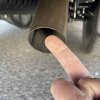The oil runs at the temperature of the engine. What differs is the viscosity of the oil at a given temperature. Even if it's 30C outside, your engine is still operating at whatever it's operating at. A 30 rated oil will have less viscosity than a 40 at operating temp. Viscosity is a measure of resistance to flow or pumping. Oil passages, pumps, and engine designs will want a certain flow of oil. But if it flows too easily, then it may not provide the lubricity that is expected by the engine designers - the oil will move away from parts too quickly or get pushed aside too easily if it is too low a viscosity.
Your cold temps aren't all that cold. OC matters, but there's not a great deal of difference between a 5W or 10W at that temperature. If you were starting typur engine from cold in -20C weather, it may matter. For cold starts, that same resistance to pumping or flow risks engine damage. For example, putting 20W oil into the S10 probably wouldn't be a good thing.
In terms of why having too low of a cold viscosity rating, I think that matters less than hot. But there's still some potential risk. How oil viscosity changes as the engine warms up is on some sort of temperature slope. As it warms up, it begins to behave more and more like its high temperature rated viscosity. So starting with too low a cold viscosity rating risks too low a viscosity as the engine warms and we start driving harder.
All that said, engine viscosity recommendations a generalization that manufacturers use. We all ride in different conditions and push the engines harder or less than others. And take what I've said here as my understanding. I'm not a lubrication engineer. Just spent a lot of time with oil and engines and too much time thinking about oil.
I hope this answers the question you had and I'm sure if I got something wrong it will be corrected.
Eville Rich





